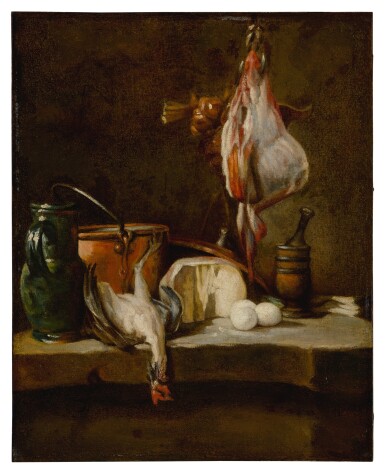Master Paintings Part II
Master Paintings Part II

Property from the Estate of Paul Kasmin
Jean Baptiste Siméon Chardin
Still Life with a ray-fish, a basket of onions, eggs, cheese, a green jug and a copper pot, with a mortar and pestle on a stone ledge
Lot Closed
January 30, 03:28 PM GMT
Estimate
40,000 - 60,000 USD
Lot Details
Description
Property from the Estate of Paul Kasmin
Jean Baptiste Siméon Chardin
Paris 1699 - 1779
Still Life with a ray-fish, a basket of onions, eggs, cheese, a green jug and a copper pot, with a mortar and pestle on a stone ledge
oil on canvas
canvas: 16 by 12 1/2 in.; 40.6 by 31.8 cm.
framed: 21 1/4 by 18 in.; 54 by 45.7 cm.
With P. & D. Colnaghi, London, 1986;
Anonymous sale, New York, Christie's, 31 May 1991, lot 18 (with incorrect provenance);
Anonymous sale, New York, Christie's, 14 January 1993, lot 101A (with incorrect provenance);
Anonymous sale, London, Sotheby's, 11 December 1996, lot 311;
With Amells Konsthandel, Stockholm;
By whom anonymously sold, New York, Sotheby's, 23 January 2003, lot 203A;
There purchased by the previous owner;
By whom sold, New York, Sotheby's, 5 June 2014, lot 48;
Where acquired by Paul Kasmin.
Chardin was perhaps the greatest still life painter of the eighteenth century, whose creativity and freedom of expression were nearly unmatched in the century. His popularity in his own lifetime is attested to by the numerous versions of his compositions which are extant. During the 1720s and 1730s Chardin developed more than twenty different still life compositions employing humble kitchen utensils. The greatest of these is the celebrated Ray-Fish of 1726-8, now in the Louvre, and the artist's reception piece for his admission into the Académie Royale de Peinture et de Sculpture in September 1728. That Chardin chose to continue to execute this specific composition points to the artist's seeming great affinity for the subject. It is known in nine autograph versions, including those in the North Carolina Museum of Art, Raleigh (signed and dated 1731); the Norton Simon Museum, Pasadena; the Wadsworth Athenaeum, Hartford; and the Dumbarton Oaks Museum.1
1. For a full list of the accepted versions, as well as a further discussion of the composition, see Literature, Rosenberg 1999, pp. 211-212.
